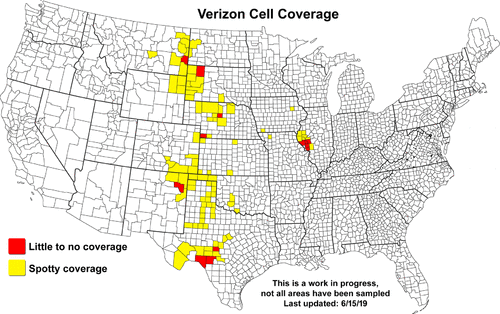ScottCurry
EF3
I actually felt like this year was better than last year. But of course that's extremely subjective. It depends upon where you chase, what carrier you have, and whether or not you have a signal booster. I have Verizon with a SureCall Fusion2Go 3.0. I also carry multiple phones with me so that I can swap them out whenever each device hits it's 20GB limit (you can buy a used phone for around $50. Activation is another $50 per device each year, and the cost for each additional device is only $10 - $15 per month). Finally, as far as where I chased this year, I spent a surprising amount of time in the Texas Panhandle, where I only lost signal in the Palo Duro Canyon.
I think the most difficult areas to get cell signal for me are in remote parts of Colorado (such as Last Chance, CO and Punkin Center, CO), canyons, and mountains. I did notice KPUB having issues delivering radar during the Lamar, CO tornado. I heard someone on the radio say to switch to Goodland, and sure enough Goodland radar was being delivered just fine, while Pueblo was still lagging, sometimes only delivering data once every 15 minutes. Someone else on the radio thought they were having cell signal issues. Turns out it was a radar data feed issue.
That said, I did notice people on the radio complaining about not getting good cell signal with AT&T in the exact same spot where I was perfectly good with Verizon. Daniel Shaw actually has service from Verizon, AT&T, Sprint, and T-Mobile. He decided not to turn on his T-Mobile coverage this year because it was so worthless. And this year, he hasn't used Sprint yet. Although, he did switch between Verizon and AT&T quite a bit.
I think the most difficult areas to get cell signal for me are in remote parts of Colorado (such as Last Chance, CO and Punkin Center, CO), canyons, and mountains. I did notice KPUB having issues delivering radar during the Lamar, CO tornado. I heard someone on the radio say to switch to Goodland, and sure enough Goodland radar was being delivered just fine, while Pueblo was still lagging, sometimes only delivering data once every 15 minutes. Someone else on the radio thought they were having cell signal issues. Turns out it was a radar data feed issue.
That said, I did notice people on the radio complaining about not getting good cell signal with AT&T in the exact same spot where I was perfectly good with Verizon. Daniel Shaw actually has service from Verizon, AT&T, Sprint, and T-Mobile. He decided not to turn on his T-Mobile coverage this year because it was so worthless. And this year, he hasn't used Sprint yet. Although, he did switch between Verizon and AT&T quite a bit.

